The Museum of Russian Art: TMORA, Minneapolis, Minnesota, USA
The Museum of Russian Art, a nonprofit museum in Minneapolis, Minnesota, United States, is the only major institution in North America devoted entirely to Russian art and culture from the entire scope of Russia’s history.
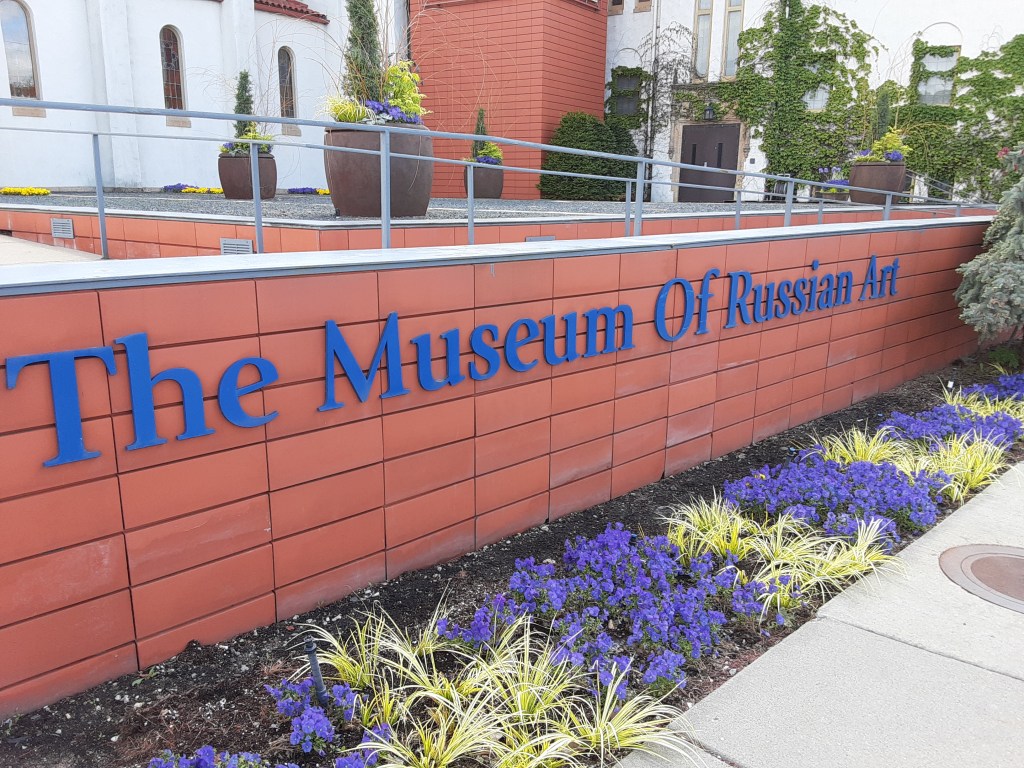
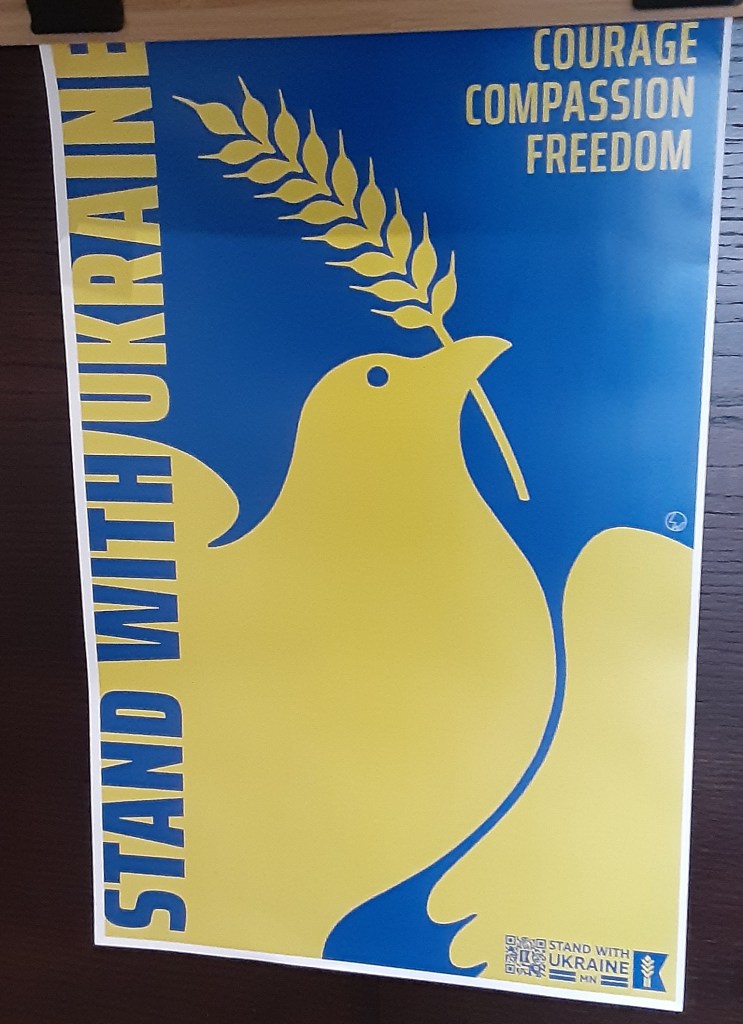
The Museum of Russian Art stands with the people of Ukraine.
TMORA urges Russia to cease hostilities immediately and withdraw.
TMORA demonstrates its support of Ukraine through Art
The Museum of Russian Art – TMORA – upholds an independent voice and the freedom of expression to carry out its mission unconstrained by influence from foreign governments, political actors and/or corporate or individual interests.
In fulfillment of its mission, TMORA exhibits and collects art from Armenia, Azerbaijan, Belarus, Estonia, Georgia, Kazakhstan, Kyrgyzstan, Latvia, Lithuania, Moldova, Russia, Tajikistan, Turkmenistan, Ukraine, and Uzbekistan. Additionally, the Museum exhibits and collects the work of émigré artists from those countries, with a special emphasis on artists living in Minnesota.

Russian Art – and Spanish Mission Architecture???
A Russian art museum – housed in a Spanish Mission style building – may seem a bit odd to the first time visitor!
This story is as interesting as the art itself!
- It began as a Protestant Congregational church (1925). . .
- Its architecture was driven by the passion of its pastor. . .
- It became a funeral home/memorial chapel (1974-2004) . . .
- Today it is a renowned museum of Russian art since 2004!
TMORA is a hidden gem in a city of great art museums! I was astounded at the depth and breath of its exhibits and its collection. Here is just a sample!
TRAVELER TIP: I was excited to learn that TMORA has announced the premier of its permanent collection online. Now you can begin to explore the collection at home, with multiple search options available to you when you click on “View all Works” on the website’s landing page. (tmora.org)
Architecture
TMORA Architecture & History
The church’s first resident pastor, the Rev. Silas Meckel fell in love with the architecture of the Mission Trail on a trip south to the Mission Valley. Upon returning to Minnesota, he requested that the new church building reflect those Texas Missions.
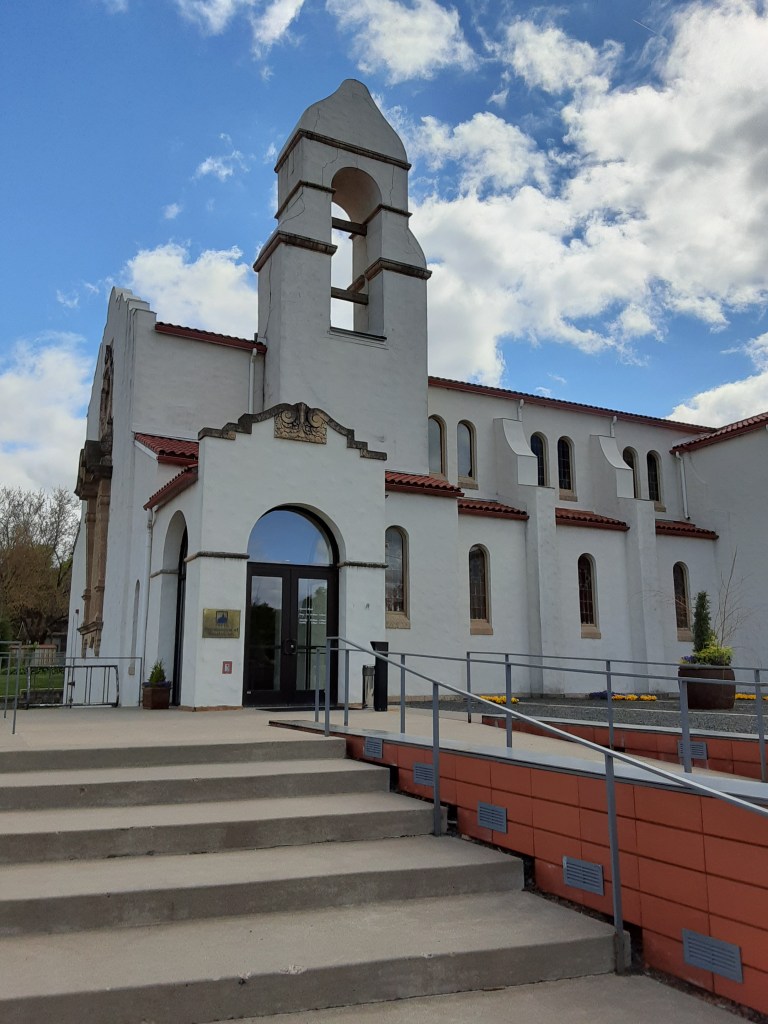
P.C. Cher B 5/26/22
The Spanish Mission style was neither Congregational nor Minnesotan. But it was a style that the Meckels were fond of – and the congregation was extremely fond of the Meckels – so it was built (from tmora.org; Mayflower Journey, p. 6-7).
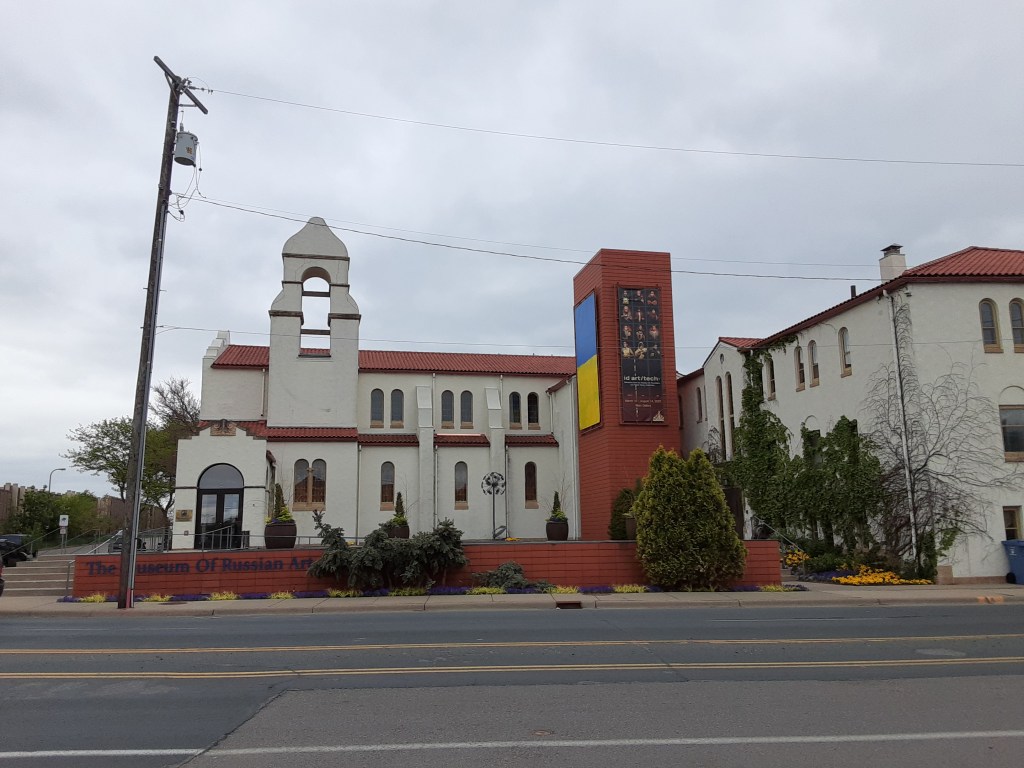
P.C. Cher B 5/26/22
The building style is Spanish Colonial-Revival, with architectural elements based on the Texas Mission in San Antonio. The facade silhouette resembles Mission San Antonio de Valero, also known as the Alamo. The pierced belfry, multiple arches, Romanesque windows, stucco walls, large wooden beams, and terra cotta tile roofs are all common to the Mission style.

The Rose window and stone carvings are adapted from Mission San Jose y San Miguel de Aguayo, also in San Antonio.

Spaces in the Museum
Church to Memorial Chapel space
The Mayflower congregation moved into its new church across the street (1974). Enga Memorial Chapel purchased the building, saved it from demolition, and operated here for nearly 30 years.

P.C. Cher B 5/26/22

Mezzanine/Balcony space
The space that was once the sanctuary is now main room of the museum. A mezzanine/balcony expands the viewing space while showcasing the original architecture.

P.C. Cher B. 5/26/22
Fireplace Room space
The cozy Fireplace Room is transformed to a wonderful space for smaller exhibits and meetings.

Gift Shop space
The Gift Shop on the 2nd floor just off of the mezzanine highlights the features of the building.

The Museum of Russian Art

The Museum of Russian Art acquired the site (2004) and converted it into a world class art museum.
- The design concept preserves the original architectural character.
- It stylistically distinguishes the new from the old.
- The new elevator shaft covered in terra cotta tile references the original clay tile roof.
- The mezzanine construction is designed for transparency, allowing both the art and the architectural elements to be seen throughout the space.
- The museum-quality environmental systems are seamlessly woven into the structure.
The unique building has a rich history of service and dignity from church. . . to memorial chapel. . . . to art museum.
The Museum of Russian Art continues these traditions through the exploration of the art and culture of Muscovite Russia, the Russian Empire, the Soviet Union, its former republics, and post-Soviet Russia.
Political Cartoons
TMORA Ukraine & Russian Political Cartoons
Political Cartoons by Ukrainian and Russian artists runs from 02 May 2022 – End of War. Anti-war political cartoons include recent works by renowned cartoonists from Ukraine and Russia created in response to the Russian aggression in Ukraine.
TMORA exhibit was created in collaboration with Audrey Feldshteyn who has worked for over 40 years in the the genre of political cartoons. At the beginning of the war, she approached a number of artists with an invitation to share their works for this exhibition. They sent their amazing works, now displayed at TMORA.
Audrey writes, “Wars destroy human relationship. But political cartoonists inhabit a country of their own governed by the law of that genre…I wanted to attract artists to a collaborative project exposing the aggressor, pointing to the perpetrator, and uniting artists against their common enemy, Putin’s regime waging a war of aggression on Ukraine.” (TMORA exhibit placard)

P.C. Cher B. 5/6/22
The international cartoonist community response for the project was overwhelmingly positive. Works by Ukrainian and Russian cartoonists living in Ukraine, Russian, USA, France and other countries are included in this exhibit.
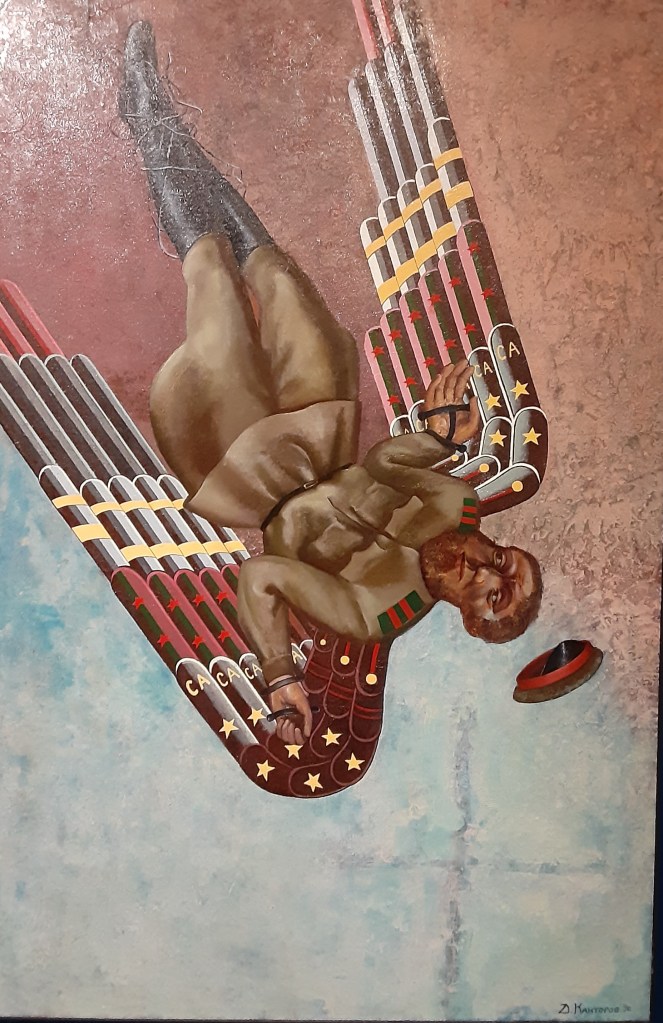
P.C. Cher B 5/26/22
Religious symbolism is seen in this political cartoon which uses the Ukrainian national flower symbolically nailed to a cross.
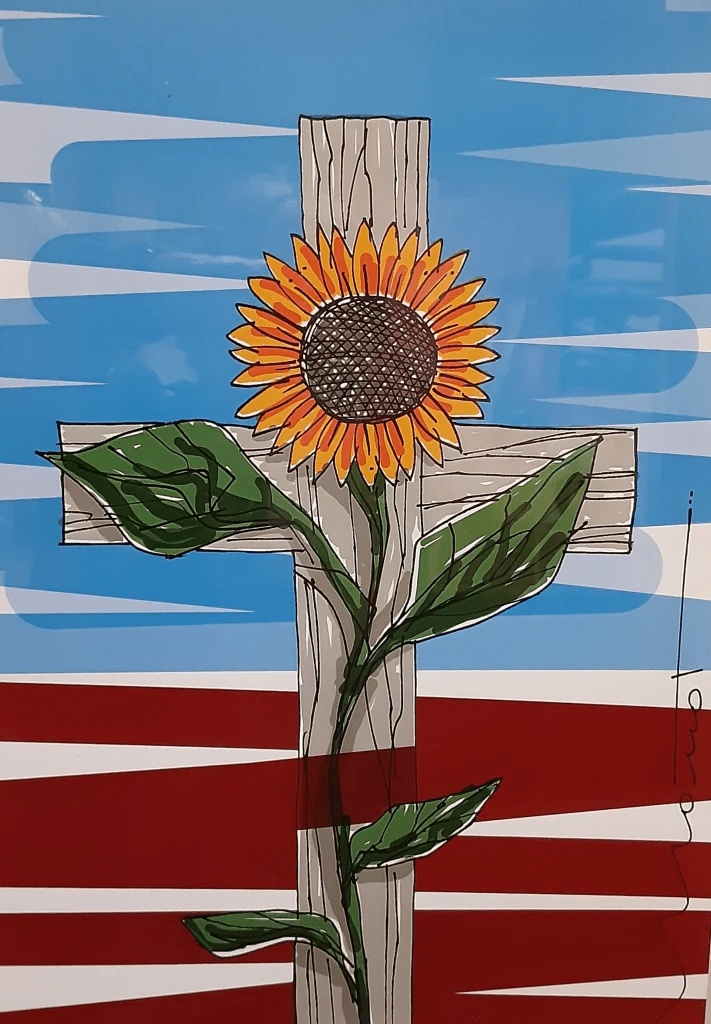
P.C.. Cher B 5/6/22
Political Cartoons: A Sampling
It was difficult to select a couple cartoons to post from so many great options. I encourage everyone to visit the exhibit and check them out on their own – either in person or online.

P.C. Cher B 5/26/22
Political cartoons by Denis Lopatin were especially provocative. Raised and educated in Belarus (b. 1977), he resided in Russian Far East, moved to France in 2018 to flee persecution for a cartoon featuring a member of the State Duma. He has published more than 1500 cartoons, 250 comics and articles.
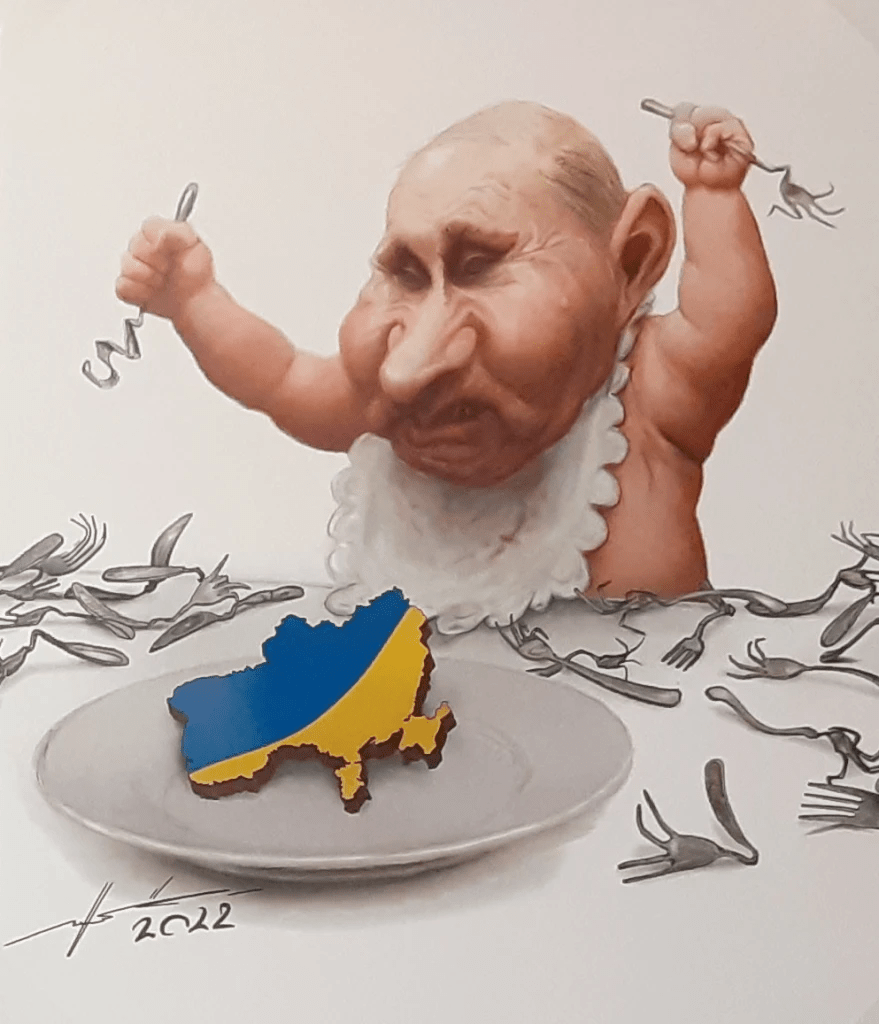
P.C. Cher B 5/26/22
The cartoons blasting Putin seemed to be of most interest to me! Maybe because they were so straight-forward and easy to understand!
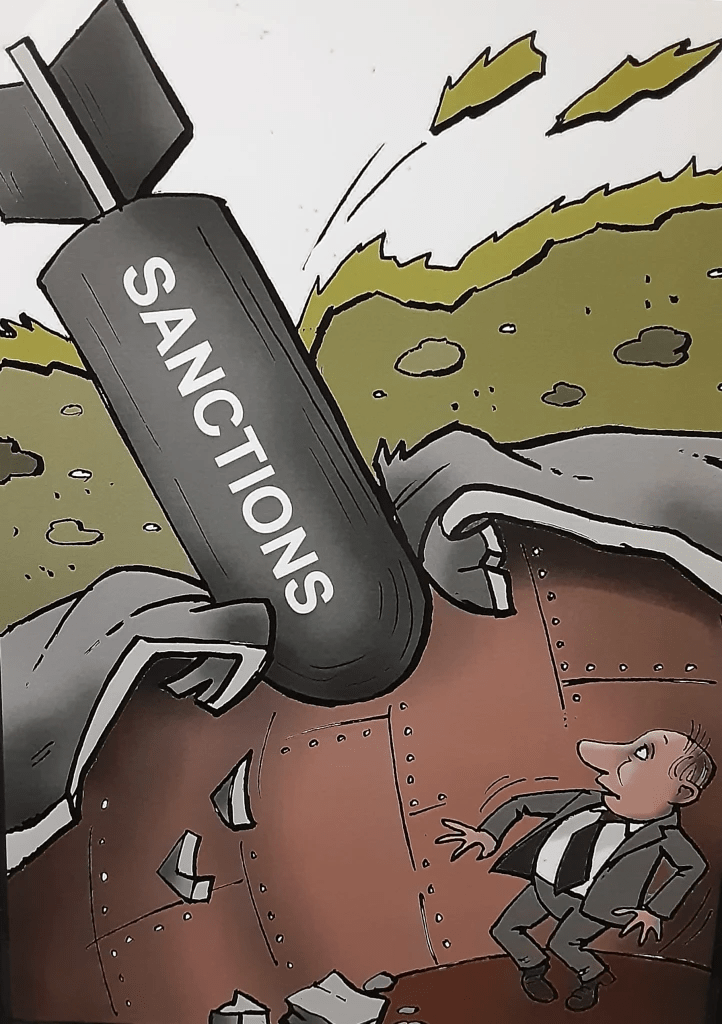
The cartoons of Victor Holub were also intriguing. He lived and worked in Ukraine since 1978. Hundreds of his cartoons have appeared in more than 30 Soviet-era and post-Soviet Ukrainian publications. He is a winner in the 13th International Contest of Caricature and Cartoons, 2020 Luxembourg.

P.C. Cher B. 5/6/22
Permanent Collection
TMORA Permanent Collection
TMORA permanent collection is extensive – much more extensive than one would imagine in such a small museum. Choosing a few to showcase was difficult. These are a few of my favorites.
“Motherland Greets a Hero” (1961) – Yuri Gagarin is honored in this HUGE painting! It covered a whole wall! The first human in outer space, Gagarin orbited the Earth in the Russian spacecraft Vostok 1 on April 12, 1961. “Motherland” is represented by inclusion of Soviet leader Nikita Khrushchev and General Secretary Brezhnev and other Soviet leaders.

P.C. Cher B. 5/26/22
“Milkmaids, Novella” (1962) – captures the joy of a shared joke during a midday break on a collective Russian farm. One of the most popular artworks exhibited in TMORA, it is currently on display in the Gift Shop. Nikolai Baskalov draws on his life growing up in a large Russian peasant family.

P.C. Cher B 5/26/22
“Thirst” (1964) – is a portrayal of the Civil War of 1918-22. In this spirited depiction of Soviet youth, Bozhil emphasizes the heroism and humanity of revolutionary soldiers. He espoused the style of Revolutionary Romanticism within the larger Socialist Realist framework.
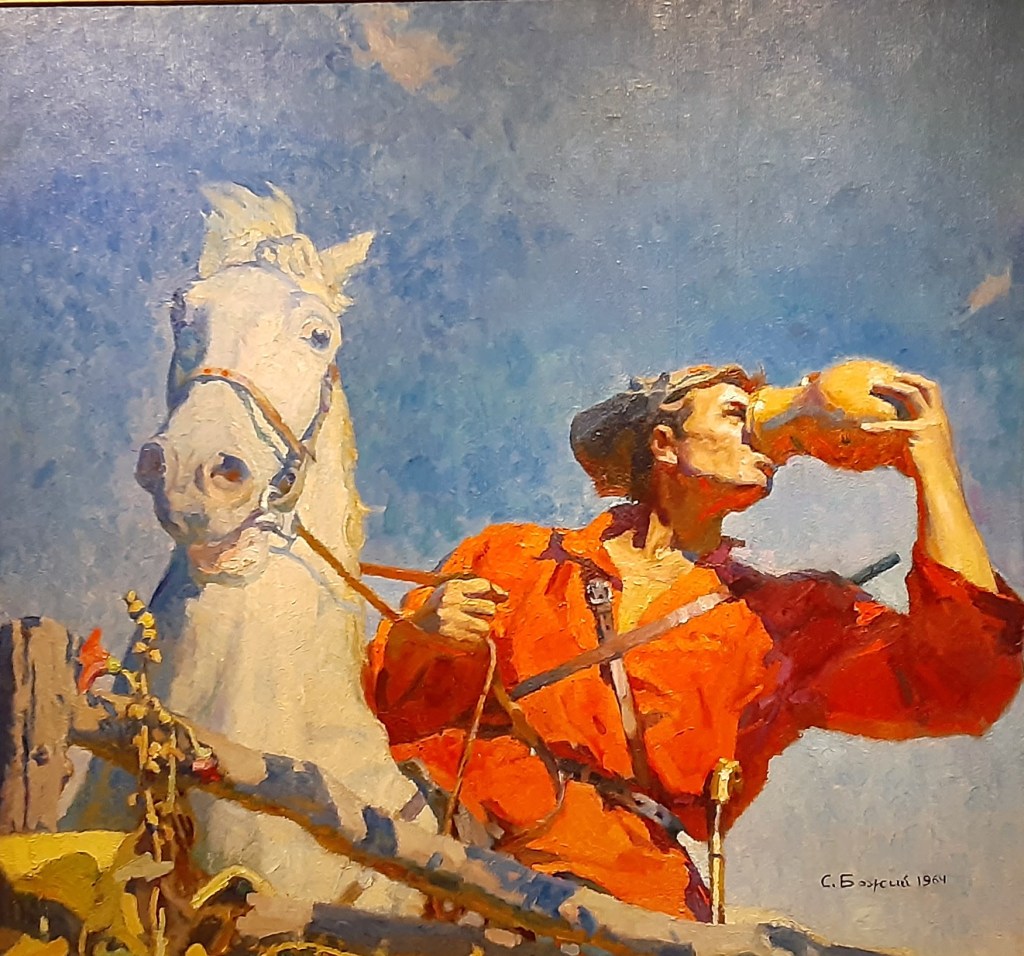
P.C. Cher B 5/26/22
“Old Woman” (1958) – represents the acceptable and appropriate style of Russian art of this time. Born in Ukraine, Egidis studied in the USSR’s best art school, becoming a professional artist within the Soviet Artists’ Union.

P.C. Cher B 5/6/22
“Among the Birch Trees” (1962) is one of my favorites. I enjoy this painting as the young lady seems to be “one” with the trees! Birch trees are Russia’s most common deciduous tree. A symbol of Russia, it has been exalted in folklore, poetry, songs and visual art. Kitaev portrays majestic birches with botanical precision, as well as with loving admiration for the trees natural beauty.
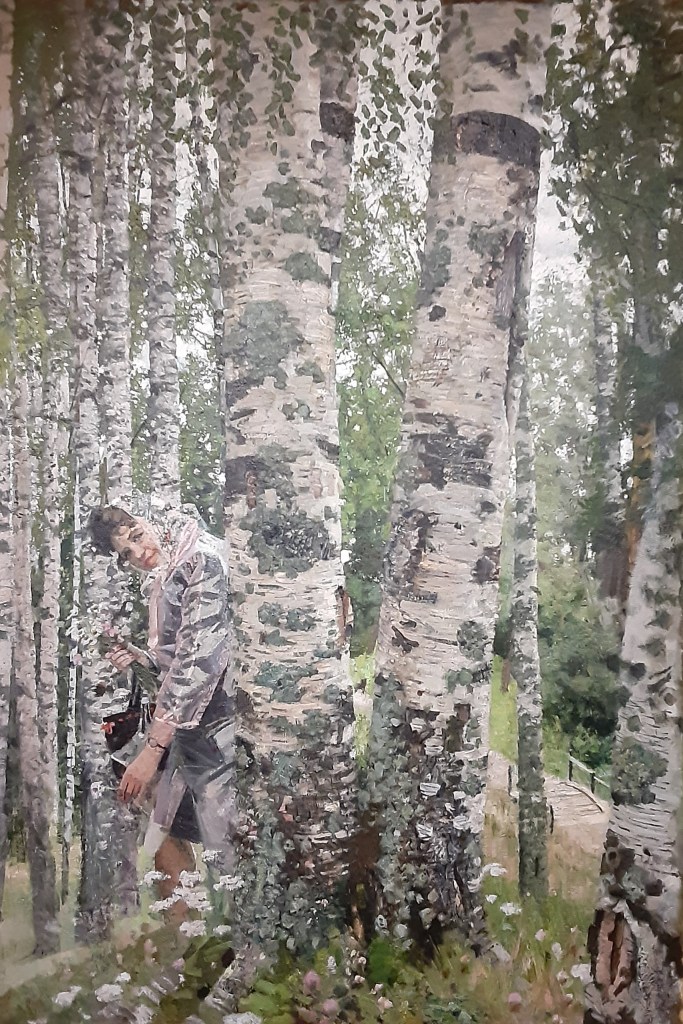
P.C. Cher B 5/26/22
Main Floor Exhibit
TMORA Art Exhibit on Main Floor
The main floor exhibits change on a regular basis.

The current exhibit showcases art work by 45 Russian, Ukrainian and Russian-American artists in a variety of genre, mediums and objectives.
As an Art History professor, I was aware that the 20th century was a tumultuous – and dangerous – time for artists in the Soviet Union and any communist country. Many immigrated to the West – primarily France and the USA – to fulfill their creative endeavors. I was intrigued by the mention of these movements in the bios in this exhibit, highlighted below.
My Exhibit Favs
“Fall Portrait, Kira” (1980). I found this portrait interesting, but the artist’s story even more-so. Oleg Vassilev was one of the celebrated canon of unofficial artists of the Soviet 1960-1980s (Khrushchev/Brezhnev era) whose creative impulses ran counter to the accepted and acceptable principles of official Soviet art.
Vassilev and members of the artistic underground created their pioneering works in the seclusion of their apartments and studios, having little hope of every exhibiting or selling their paintings in their home country. After the collapse of the Soviet Union, they began exhibiting. He moved to the USA in the 1990s, and lived in New York and Minnesota.

“Self Portraits of Shimon Okshteyn [A Set of Six]” (2012). This colorful, captivating work was self-explanatory and unavoidable as it emerges immediately into one’s path when entering the main gallery! Born in Ukraine, Okshteyn lived and worked in the USA from 1980.

“Recalcitrant” and “Trail of Revolutionaries” (2009). I found these two paintings by contemporary Russian-American artist, Yalery Yershow, to be intriguing! The TMORA info was uncharacteristically absent on Yershow and his work. Online research was little help. Interestingly, it seems that is what the artist wants. “Valery does not impose his own readings on his art; instead, he plays on the ambivalence of meaning, encouraging discussion of his work.” (Natalia Kolodzei, valery-yershov.herokuapp.com/ )


“Lenin and Giacometti” (1989). Putting these two individuals together in a work of art seemed unlikely. Leonid Sokov is associated with a notable development in Moscow’s unofficial art scene in the 1970s called the Sots Art movement. Similar to American pop art, they playfully used – or misused – Soviet ideological codes, transforming them from fearsome symbols of power to amusing playthings. Sokov was born in the Tver region, studied at some of Russian’s best art schools. In 1980, he immigrated to the USA and settled in New York.

Siberia
TMORA Photos of An American in Siberia
This temporary exhibit on the mezzanine level of TMORA are unique photographs documenting the 1931-1932 trip to Siberia of Carl Holschuh, skilled amateur photographer. The exhibit is at TMORA 26 March – 21 August, 2022.

We witness a rare insider’s look at the construction of the project, its sites, and people, drawn from the family archives of Holschuh’s grandson, Minnesota resident, Charles Lane,
An expert in the operation of blast furnaces, Holschuh was hired by a Chicago-based engineering company to work at the Kuznetsk site (1931).

One of the key points in Stalin’s vast industrialization program was the construction of a large steel mill in Kuznetsk, Southern Siberia. Like many of his other projects, it involved Western European and American companies.
“Employees of the American Hotel” Photo of maids in Holschuh’s apartment.

P.C. Cher B 4/26/22
“Mr. Glenn in his droski” Each apartment had a droski – sled or buggy-like vehicle pulled by a small horse – furnished by the Russian government, to take Holschuh and family where-ever they cared to go.
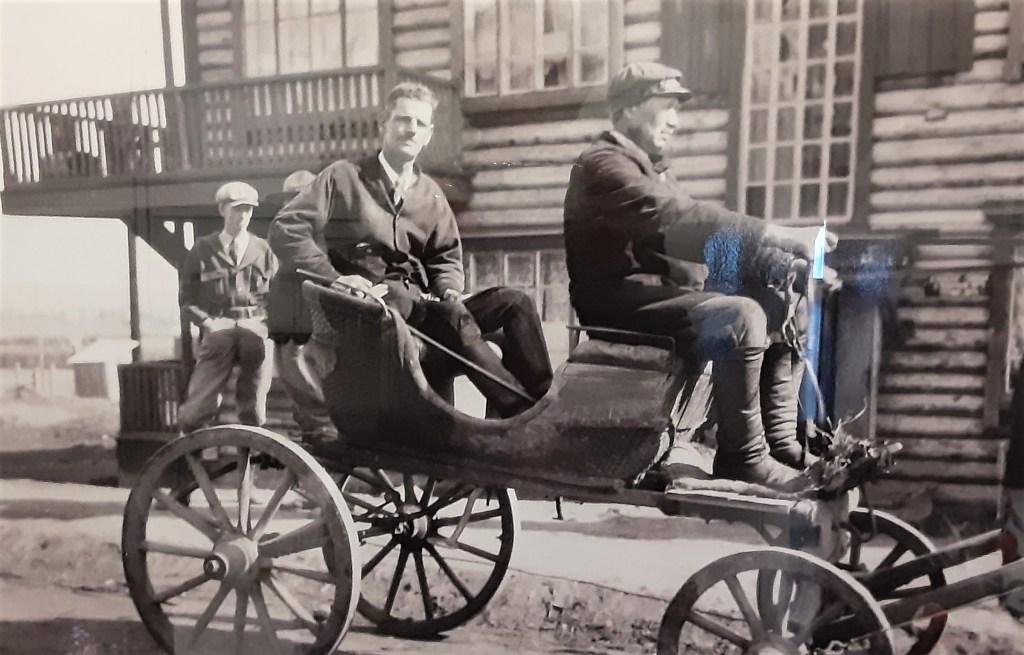
P.C. Cher B 4/26/22
“Family in front of Sod House” Local Russian families lived in sod houses. I loved Holschuh’s description of them: “… a well-scrubbed board floor, a table, stools, curtains at the small paned windows, a brick stove covered with plaster and whitewashed…” And, I love this part “an icon or picture of Lenin in the corner.” (Icon OR Lenin?!)
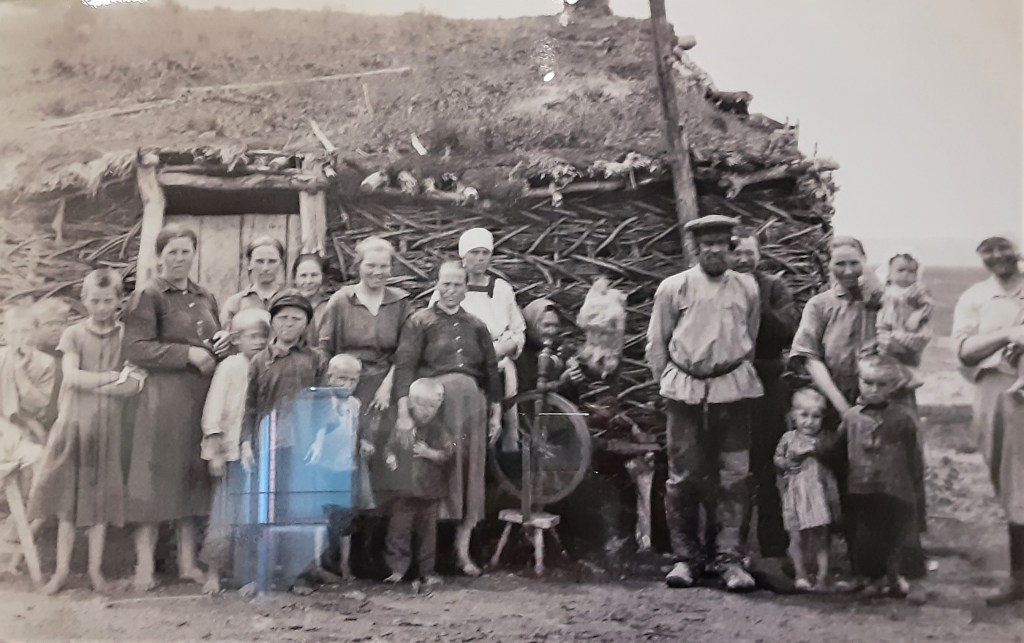
P.C. Cher B. 4/26/22
“Residents of Kuznetsk” is my favorite photo of this collection!

P.C. Cher B. 4/26/22
Still Life Art
TMORA Still Life Art in Fireplace Room Gallery
This exhibit runs from March 12, 2022 – August 14, 2022 and is available on the website archives and virtual tours.
Alek Buzhaker: The Art of Still Life
TMORA Fireplace Room Gallery showcased still life paintings by Russian born, Minnesota artist Alek Buzhaker. Painted during the recent decade, these works express his passion and admiration for this time-honored genre.
Born in Crimea (1947), Buzhaker’s family lived in Leningrad (now St. Petersburg), Russia.

P.C. Cher B. 5/26/22
He received professional training at the Mukhina College of Art & Design (now St. Petersburg Stieglitz State Academy of Art & Design).

P.C. Cher B. 5/26/22
Buzhaker’s family emigrated to the USA (1971). He currently lives in the Twin Cities of Minneapolis/St. Paul, Minnesota.

P.C. Cher B. 5/26/22
Gift Shop
TMORA Gift Shop
From the Baltic to the Black Sea – and Beyond… the TMORA Shop is a “gallery within a gallery, carefully curated and beautifully unique.”
Located on the museum’s mezzanine level, it is open 7 days a week. Can’t get to Minneapolis? Shop online shoptmora.org
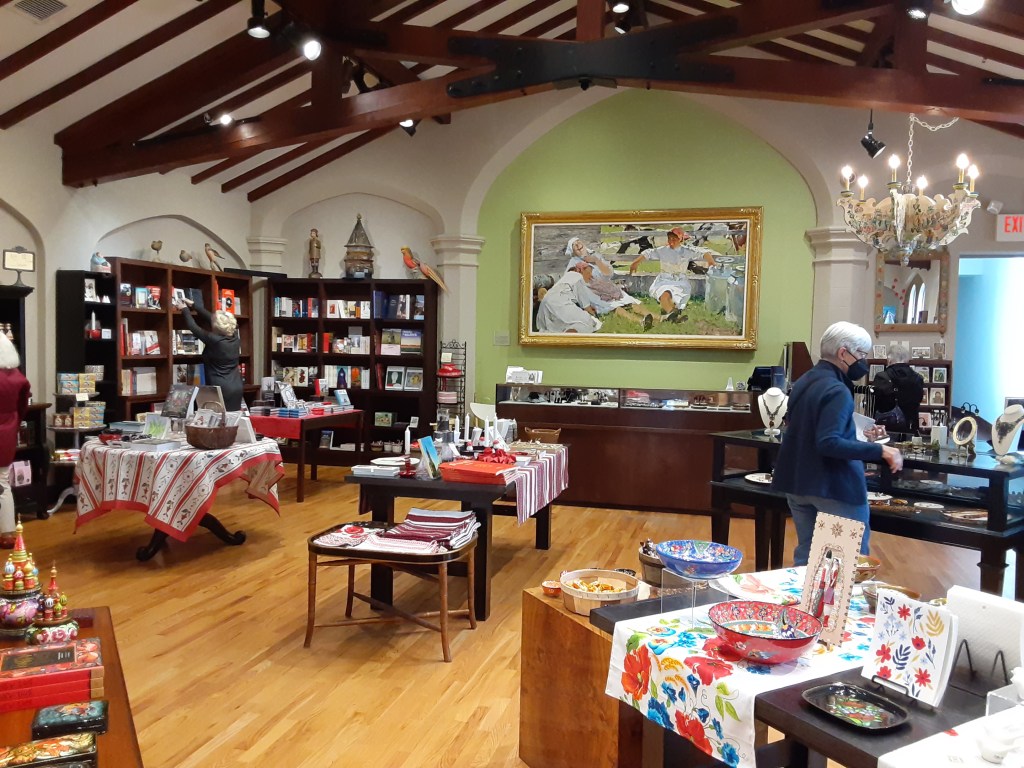
The gift shop sells items with Russian designs from items such as napkins, tableware, greeting cards, nesting dolls – to exquisite fine jewelry. (I loved their jewelry made of amber.)
Currently on display in the gift shop is one of the most popular artworks exhibited in TMORA, becoming part of its permanent collection in 2015, “Milkmaids, Novella.”
VISIT
Visit TMORA
- Address: 5500 Stevens Ave, Minneapolis, MN 55419. Corner of East Diamond Lake Road and Stevens Avenue. Easy access from 35W South of downtown Minneapolis, Diamond Lake Road exit.
- Parking: Easy free parking across the street at Mayflower Church.
- Admission: See website. Discounts for military, students and seniors. Consider membership benefits
- Website: tmora.org
Online Exhibits
TMORA Virtual & Online Exhibits
Can’t get to Minneapolis? Missed a past exhibit? TMORA provides opportunities for you to experience this unique experience from the comfort of your home computer.
- ONLINE EXHIBITIONS: tmora.org/online-exhibitions/ Time travel to the past by viewing a selection of exhibitions previously hosted at TMORA. Many of these collections of artifacts will never be seen together again.
- VIRTUAL TOURS: tmora.org/programs/virtual-programming/ Take a virtual tour of each foray into Russian art and history by clicking on the topics of interest. Detailed descriptions guide your way.
- ONLINE COLLECTION: TMORA permanent collection online – Explore the collection at home, with multiple search options available. Click on “View all Works” on the website’s landing page.
Sources
- Photos by Cher B. unless otherwise noted. 26 May 2022
- Independent Museum Tour led by Cher B, Charamana Consulting. 26 May 2022
- Kolodzei, Natalia. valery-yershov.herokuapp.com/
- The Museum of Russian Art website: tmora.org
- TMORA Wall plaques next to the art and exhibitions on site at TMORA
i see bottles!! Maybe you ought to get out the paints and create another bottle painting!.
LikeLiked by 1 person
Yes! Bottles! Vases! Good idea!
LikeLike
Wonderfully & extensively covered article on RMOA. Learned a few things that I missed on the visit along with some good reminders. Different perspective always helpful. Thanks!
LikeLiked by 1 person
Thanks! It was a fun day. So much to see and cover because it was such a big exhibit even if it is not a big place – yet not crowded. A real hidden gem of a museum!
LikeLike
This was great seeing another hidden treasure in our beautiful twin cities.
LikeLiked by 1 person
Yes!
LikeLike
I visited years ago. I need to get back!
LikeLiked by 1 person
Yes! They pack so much into such a small place – and it is every changing!
LikeLike